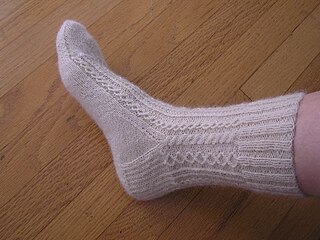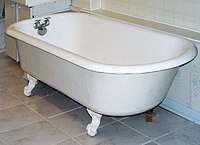
The foot is an anatomical structure found in many vertebrates. It is the terminal portion of a limb which bears weight and allows locomotion. In many animals with feet, the foot is a separate organ at the terminal part of the leg made up of one or more segments or bones, generally including claws and or nails.
In neuroanatomy, a plexus is a branching network of vessels or nerves. The vessels may be blood vessels or lymphatic vessels. The nerves are typically axons outside the central nervous system.

Standard anatomical terms of location are used to unambiguously describe the anatomy of animals, including humans. The terms, typically derived from Latin or Greek roots, describe something in its standard anatomical position. This position provides a definition of what is at the front ("anterior"), behind ("posterior") and so on. As part of defining and describing terms, the body is described through the use of anatomical planes and anatomical axes.

A cushion is a soft bag of some ornamental material, usually stuffed with wool, hair, feathers, polyester staple fiber, non-woven material, cotton, or even paper torn into fragments. It may be used for sitting or kneeling upon, or to soften the hardness or angularity of a chair or couch. Decorative cushions often have a patterned cover material, and are used as decoration for furniture.

A paw is the soft foot-like part of a mammal, generally a quadruped, that has claws.

A couch, also known as a sofa, settee, or chesterfield, is a cushioned item of furniture for seating multiple people. It is commonly found in the form of a bench with upholstered armrests and is often fitted with springs and tailored cushion and pillows. Although a couch is used primarily for seating, it may be used for sleeping. In homes, couches are normally put in the family room, living room, den, or lounge. They are sometimes also found in non-residential settings such as hotels, lobbies of commercial offices, waiting rooms, and bars. Couches can also vary in size, color, and design.

Molding or moulding is the process of manufacturing by shaping liquid or pliable raw material using a rigid frame called a mold or matrix. This itself may have been made using a pattern or model of the final object.

In terrestrial vertebrates, digitigrade locomotion is walking or running on the toes. A digitigrade animal is one that stands or walks with its toes (phalanges) on the ground, and the rest of its foot lifted. Digitigrades include birds, cats, dogs, and many other mammals, but not plantigrades or unguligrades. Digitigrades generally move more quickly and quietly than other animals.

A meterstick, metrestick, or yardstick is either a straightedge or foldable ruler used to measure length, and is especially common in the construction industry. They are often made of wood or plastic, and often have metal or plastic joints so that they can be folded together. Normal length of a meterstick made for the international market is either one or two meters, while a yardstick made for the U.S. market is typically one yard long.
In phonetics and phonology, checked vowels are those that commonly stand in a stressed closed syllable; and free vowels are those that can stand in either a stressed closed syllable or a stressed open syllable.

The Monkey and the Cat is best known as a fable adapted by Jean de La Fontaine under the title Le Singe et le Chat that appeared in the second collection of his Fables in 1679 (IX.17). Although there is no evidence that the story existed before the 15th century, it began to appear in collections of Aesop's Fables from the 17th century but is not included in the Perry Index.

A tuyere or tuyère is a tube, nozzle or pipe through which air is blown into a furnace or hearth.
A hindlimb or back limb is one of the paired articulated appendages (limbs) attached on the caudal (posterior) end of a terrestrial tetrapod vertebrate's torso. With reference to quadrupeds, the term hindleg or back leg is often used instead. In bipedal animals with an upright posture, the term lower limb is often used.

A sock is a piece of clothing worn on the feet and often covering the ankle or some part of the calf. Some types of shoes or boots are typically worn over socks. In ancient times, socks were made from leather or matted animal hair. In the late 16th century, machine-knit socks were first produced. Until the 1800s, both hand-made and machine-knit socks were manufactured, with the latter technique becoming more common in the 19th century.

A leg is a weight-bearing and locomotive anatomical structure, usually having a columnar shape. During locomotion, legs function as "extensible struts". The combination of movements at all joints can be modeled as a single, linear element capable of changing length and rotating about an omnidirectional "hip" joint.
A foot is the floor level termination of furniture legs. Legless furniture may be slightly raised off of the floor by their feet.

In anatomy, the venae cavae are two large veins that return deoxygenated blood from the body into the heart. In humans they are the superior vena cava and the inferior vena cava, and both empty into the right atrium. They are located slightly off-center, toward the right side of the body.
Animal furniture refers both to furniture used by animals and to furniture made from animals.
The retail format influences the consumer's store choice and addresses the consumer's expectations. At its most basic level, a retail format is a simple marketplace, that is; a location where goods and services are exchanged. In some parts of the world, the retail sector is still dominated by small family-run stores, but large retail chains are increasingly dominating the sector, because they can exert considerable buying power and pass on the savings in the form of lower prices. Many of these large retail chains also produce their own private labels which compete alongside manufacturer brands. Considerable consolidation of retail stores has changed the retail landscape, transferring power away from wholesalers and into the hands of the large retail chains.













